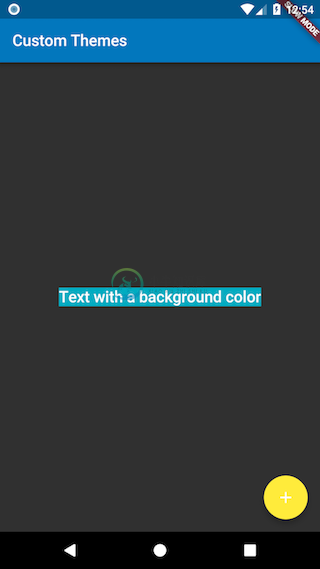Using Themes to share colors and font styles
In order to share colors and font styles throughout our app, we can take advantage of themes. There are two ways to define themes: App-wide or using Theme Widgets that define the colors and font styles for a particular part of our application. In fact, app-wide themes are just Theme Widgets created at the root of our apps by the MaterialApp!
After we define a Theme, we can use it within our own Widgets. In addition, the Material Widgets provided by Flutter will use our Theme to set the background colors and font styles for AppBars, Buttons, Checkboxes, and more.
Creating an app theme
In order to share a Theme containing colors and font styles across our entire app, we can provide ThemeData to the MaterialApp constructor.
If no theme is provided, Flutter creates a fallback theme under the hood.
MaterialApp(
title: title,
theme: ThemeData(
// Define the default Brightness and Colors
brightness: Brightness.dark,
primaryColor: Colors.lightBlue[800],
accentColor: Colors.cyan[600],
// Define the default Font Family
fontFamily: 'Montserrat',
// Define the default TextTheme. Use this to specify the default
// text styling for headlines, titles, bodies of text, and more.
textTheme: TextTheme(
headline: TextStyle(fontSize: 72.0, fontWeight: FontWeight.bold),
title: TextStyle(fontSize: 36.0, fontStyle: FontStyle.italic),
body1: TextStyle(fontSize: 14.0, fontFamily: 'Hind'),
),
)
);
Please see the ThemeData documentation to see all of the colors and fonts you can define.
Themes for part of an application
If we want to override the app-wide theme in part of our application, we can wrap a section of our app in a Theme Widget.
There are two ways to approach this: creating unique ThemeData, or extending the parent theme.
Creating unique ThemeData
If we don’t want to inherit any application colors or font styles, we can create a ThemeData() instance and pass that to the Theme Widget.
Theme(
// Create a unique theme with "ThemeData"
data: ThemeData(
accentColor: Colors.yellow,
),
child: FloatingActionButton(
onPressed: () {},
child: Icon(Icons.add),
),
);
Extending the parent theme
Rather than overriding everything, it often makes sense to extend the parent theme. We can achieve this by using the copyWith method.
Theme(
// Find and Extend the parent theme using "copyWith". Please see the next
// section for more info on `Theme.of`.
data: Theme.of(context).copyWith(accentColor: Colors.yellow),
child: FloatingActionButton(
onPressed: null,
child: Icon(Icons.add),
),
);
Using a Theme
Now that we’ve defined a theme, we can use it within our Widget build methods by using the Theme.of(context) function!
Theme.of(context) looks up the Widget tree and return the nearest Theme in the tree. If we have a stand-alone Theme defined above our Widget, it returns that. If not, it returns the App theme.
In fact, the FloatingActionButton uses this exact technique to find the accentColor!
Container(
color: Theme.of(context).accentColor,
child: Text(
'Text with a background color',
style: Theme.of(context).textTheme.title,
),
);
Complete example
import 'package:flutter/foundation.dart';
import 'package:flutter/material.dart';
void main() {
runApp(MyApp());
}
class MyApp extends StatelessWidget {
@override
Widget build(BuildContext context) {
final appName = 'Custom Themes';
return MaterialApp(
title: appName,
theme: ThemeData(
// Define the default Brightness and Colors
brightness: Brightness.dark,
primaryColor: Colors.lightBlue[800],
accentColor: Colors.cyan[600],
// Define the default Font Family
fontFamily: 'Montserrat',
// Define the default TextTheme. Use this to specify the default
// text styling for headlines, titles, bodies of text, and more.
textTheme: TextTheme(
headline: TextStyle(fontSize: 72.0, fontWeight: FontWeight.bold),
title: TextStyle(fontSize: 36.0, fontStyle: FontStyle.italic),
body1: TextStyle(fontSize: 14.0, fontFamily: 'Hind'),
),
),
home: MyHomePage(
title: appName,
),
);
}
}
class MyHomePage extends StatelessWidget {
final String title;
MyHomePage({Key key, @required this.title}) : super(key: key);
@override
Widget build(BuildContext context) {
return Scaffold(
appBar: AppBar(
title: Text(title),
),
body: Center(
child: Container(
color: Theme.of(context).accentColor,
child: Text(
'Text with a background color',
style: Theme.of(context).textTheme.title,
),
),
),
floatingActionButton: Theme(
data: Theme.of(context).copyWith(accentColor: Colors.yellow),
child: FloatingActionButton(
onPressed: null,
child: Icon(Icons.add),
),
),
);
}
}


